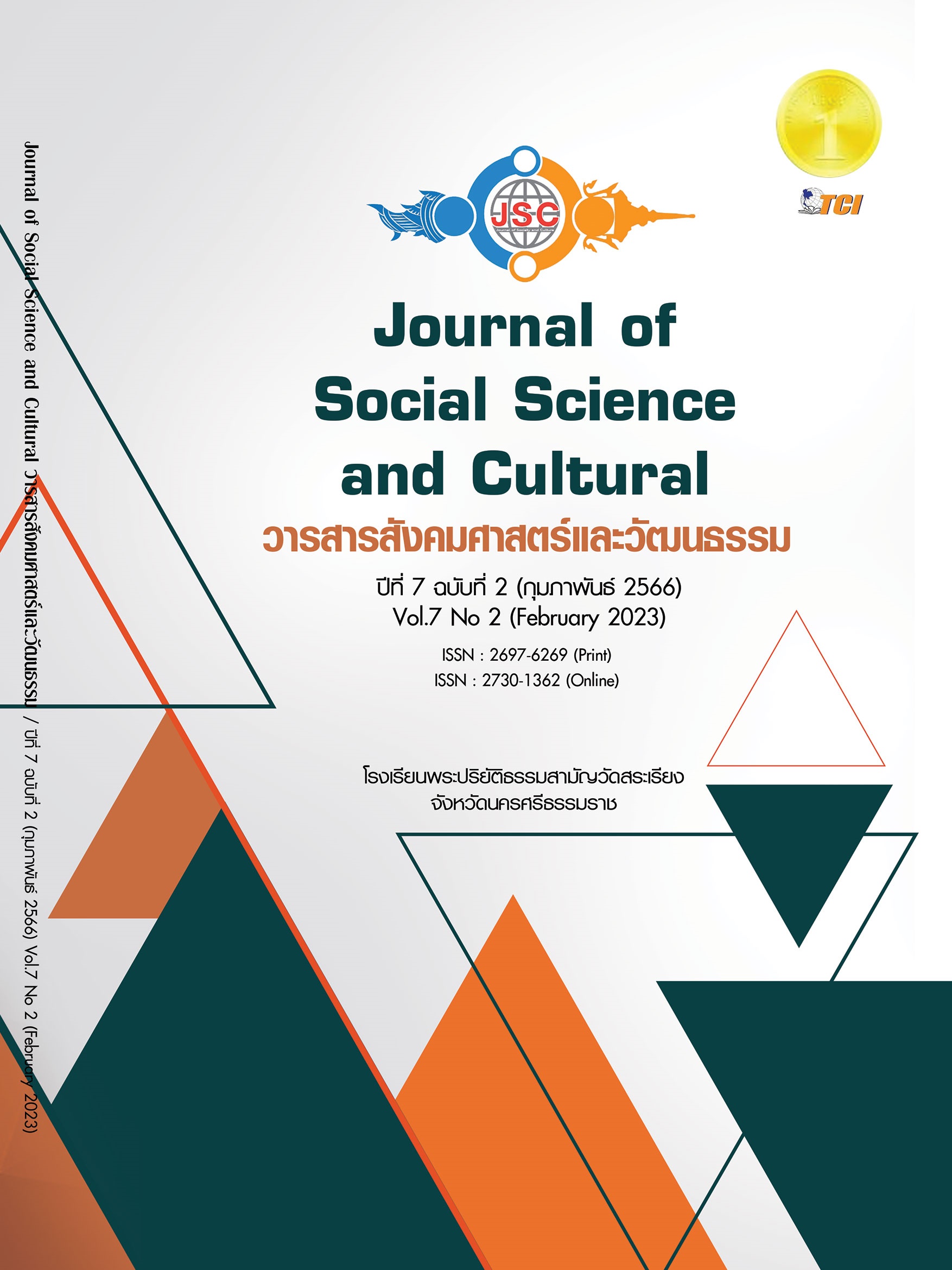VALUE CHAIN MANAGEMENT PLA SAI UAN PRODUCTS OF COMMUNITY ENTERPRISES IN NAKHON SI THAMMARAT PROVINCE TO INCREASE COMPETITIVENESS
Main Article Content
Abstract
The objectives of this research paper were 1) to assess the value chain, value added, and the proportion of income of Pla Sai Uan (fermented fish) products, 2) to analyze the value chain management guidelines in order to enhance the competitiveness of Pla Sai Uan products, and 3) to assess the current and new value chains for measuring value added and the proportion of income of each Pla Sai Uan product. This was mixed methods research. The populations were community enterprises producing Pla Sai Uan in Nakhon Si Thammarat province. 12 sample groups were selected by using the purposive sampling method. Research Instrument was a structured interview. Data collection included the production process, production quantity, prices, and production costs for calculating value added and the proportion of income of each Pla Sai Uan product. The results showed that 1) After assessing the value chain, value added, and the proportion of income of Pla Sai Uan products, there were 5 stakeholders; namely, (1) fish sellers or farmers, (2) fish cutters, (3) Pla Sai Uan producers or processors, (4) sellers, and (5) consumers, 2) After analyzing the value chain management guidelines to enhance the competitiveness of Pla Sai Uan products, they could be categorized into 6 types which were reducing the joint, increasing the joint, expanding the joint, improving the current joint, developing new products, and creating the value awareness of the products, 3) the results of assessing the current and new value chains showed raw fermented fish, crispy fried fish, fish with extra ingredients, Pla Sai Uan paste, fish furikake, raw and fried fish crackers caused the highest added value of ingredients up to 2.86, 5.79, 2.84, 7.08, 7.23, 1.43, and 2.92 times respectively. It was also found that the highest ratio of revenue in the value chain was Pla Sai Uan producers while the lowest ratio of revenue in the value chain was fish fillet processors.
Article Details
References
จิตพนธ์ ชุมเกตุ. (2560). การพัฒนาผลิตภัณฑ์จากภูมิปัญญาท้องถิ่นเพื่อเพิ่มประสิทธิภาพทางการจัดการชุมชนอย่างยั่งยืนของชุมชนไทยมุสลิม อำเภอชะอา จังหวัดเพชรบุรี. ใน รายงานการวิจัย. มหาวิทยาลัยศิลปากร.
ฐิติมา บูรณวงศ์ และคณะ. (2565). การวิเคราะห์ห่วงโซ่คุณค่าใหม่และการวัดการกระจายรายได้ของผลิตภัณฑ์ขนมลาในจังหวัดนครศรีธรรมราช. วารสารวิชาการบัณฑิตวิทยาลัยสวนดุสิต, 18(2), 139-155.
ฐิติมา บูรณวงศ์ และศณัทชา ธีระชุนห์. (2565). การศึกษาพฤติกรรมผู้บริโภคและแนวทางในการพัฒนาผลิตภัณฑ์ขนมลาของกลุ่มวิสาหกิจชุมชน ในจังหวัดนครศรีธรรมราช. วารสารนาคบุตรปริทรรศน์, 14(1), 43-54.
ณฐมน ทรัพย์บุญโต และคณะ. (2559). ปัจจัยที่ส่งผลต่อพฤติกรรมเลือกซื้อผลิตภัณฑ์ OTOP หนึ่งตำบลหนึ่งผลิตภัณฑ์: กรณีศึกษา OTOP ประเภทอาหาร จังหวัดพะเยา. วารสารมนุษยศาสตร์และสังคมศาสตร์, 12(ฉบับพิเศษ ประชุมวิชาการ), 230-237.
นฤมล จิตรเอื้อ และประสพชัย พสุนนท์. (2561). การใช้เครื่องมือในการเก็บรวบรวมข้อมูลงานวิจัยเพื่อการศึกษาการดำเนินการที่เป็นเลิศของสถานศึกษา. วารสารสาขามนุษยศาสตร์สังคมศาสตร์และศิลปะ, 11(2), 2118-2135.
บัณฑิต อินณวงศ์. (2564). การคลี่ภาพ Value Chain การคำนวณมูลค่าเพิ่มและสัดส่วนแบ่งรายได้ สำหรับ Local Enterprise. กรุงเทพมหานคร: หน่วยบริหารและจัดการทุนด้านการพัฒนาระดับพื้นที่ (บพท).
ปิยะวัติ บุญ-หลง และคณะ. (2559). งานวิชาการเพื่อสังคม: หลักการและวิธีการ. กรุงเทพมหานคร: สถาบันคลังสมองของชาติ.
มาริษ หัสชู. (2563). การวิเคราะห์ห่วงโซ่อุปทานและห่วงโซ่คุณค่า สำหรับแนวทางการพัฒนาวิสาหกิจชุมชนและผู้ประกอบการสินค้าโอทอป. ใน สารนิพนธ์วิทยาศาสตรมหาบัณฑิต สาขาวิชาเทคโนโลยีอาหาร. มหาวิทยาลัยศิลปกร.
วัชรินทร์ อินทพรหม. (2562). การวิเคราะห์และการนำเสนอผลการวิเคราะห์ข้อมูลเชิงคุณภาพ. วารสารวิชาการ มหาวิทยาลัยราชภัฏพระนคร, 10(2), 314-333.
ศิริเชษฐ์ สังขะมาน. (2559). การสร้างมูลค่าเพิ่มของผลิตภัณฑ์แปรรูปข้าว กรณีศึกษาจังหวัดยโสธร. กรุงเทพมหานคร: จุฬาลงกรณ์มหาวิทยาลัย.
สำนักงานคณะกรรมการนโยบายรัฐวิสาหกิจ. (2565). แผนปฏิบัติราชการรายปี (พ.ศ. 2566). เรียกใช้เมื่อ 8 มกราคม 2566 จาก https://www.sepo.go.th/tinymce/plugins/ filemanager/thumbs//แผนปฏิบัติราชการประจำปีงบประมาณ%202566.pdf
สำนักงานสภาพัฒนาการเศรษฐกิจและสังคมแห่งชาติ. (2565). แผนพัฒนาเศรษฐกิจและสังคมแห่งชาติ ฉบับที่ 13 (พ.ศ. 2566 – 2570). เรียกใช้เมื่อ 25 พฤศจิกายน 2565 จาก https://www.nesdc.go.th/
สำนักยุทธศาสตร์นโยบายและแผน. (2563). คู่มือแผนปฏิบัติราชการ ประจำปีงบประมาณ พ.ศ. 2563. เรียกใช้เมื่อ 25 พฤศจิกายน 2565 จาก https://web.codi.or.th/wp-content/uploads/2020/05/CODI-Actionplan2563.pdf
อุทิศ ทาหอม และคณะ. (2561). รูปแบบการเพิ่มมูลค่าผลิตภัณฑ์อาหารพื้นถิ่น “ตำเปียงทรงเครื่อง” เพื่อสร้างความเข้มแข็งของเศรษฐกิจชุมชนบ้านเสม็ด ตำบลหนองเต็ง อำเภอกระสัง จังหวัดบุรีรัมย์. วารสารพัฒนาสังคม, 20 (2), 35-61.
Krippendorff, K. (2004). Content analysis: an introduction to its methodology. (2nd.ed.). USA: Sage Publications.
Porter, M. E. (1985). Competitive Advantage: Creating and Sustaining Superior Performance. New York: MacMillan.


